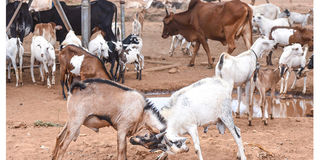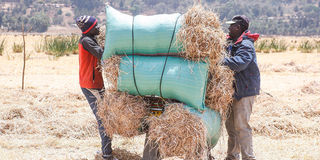How to improve livestock production in Kenya: Expert suggestions
Sponsored by Gatsby Africa

Livestock at Mbechot area in Baringo South, Baringo County.
By Evans Ongwae
Opportunities abound along Kenya’s meat value chain because demand for this livestock commodity is expected to double by 2050. As meat moves from the primary producer to the final consumer, it offers various actors the opportunity to add value and reap the benefits.
Meat is a popular livestock product consumed widely in the country, and also exported to some destinations abroad. Surging demand by both local and export markets requires the redoubling of efforts and investments by the Government, producers, marketers, and processors.
Dr John Wamahiu, a livestock expert at Gatsby Africa, argues that providing adequate fodder is an opportunity worth exploring. He points out that the rains have replenished pasture that can be cut to make hay.
Commercial opportunity
Furthermore, he adds, the government has left the task of providing livestock fodder or pasture to the private sector. As such, livestock producers shouldn’t wait for livestock feed relief. Instead, they should consider unavailability of fodder as a serious commercial opportunity. There is a strong business case for investing in preserving fodder for sale to livestock farmers who need it, especially when drought strikes.
The recent drought has demonstrated the resilience and resourcefulness of the country’s pastoralists. As the rains have returned and the grass has grown again, it is important for livestock owners to manage their resources wisely to ensure they last through the next dry season.
Dr Wamahiu adds that developing livestock farms for different aggregators could ensure processors get enough cattle to process, “so that they don’t have 50 percent idle processing capacity.”
Moreover, holding livestock during aggregation provides the opportunity to guarantee food safety, as it gives time for the withdrawal of antibiotics from the animal’s system.
Investing backwards
Dr Wamahiu challenges meat processors to consider investing backwards into livestock production. By investing earlier in the supply chain, they can influence the quality and quantity of the meat animals that will land in their abattoirs or slaughter facilities.
“You can get better quality beef when animals are kept in a farm for fattening and finishing,” he says.
He calls for the setting up of livestock farms for fattening and finishing along strategic routes, from the pastoralist rangelands to the markets where the animals are taken for slaughter and processing.
Bringing together livestock takes the market closer to producers, and allows the aggregators to add value to the animals they have bought from different places. It also helps eliminate the middlemen who often make more money than the producers they buy the livestock from.
Dr Wamahiu says this can go a long way towards increasing available livestock for growing demand for meat, both in Kenya and for export markets. It is particularly critical during droughts, when aggregators can buy livestock from producers overwhelmed with lack of enough fodder for their animals.

Livestock farmers collect grass near Lake Olbolosat in Nyandarua County
Key sector
The livestock sector accounts for 12 percent of Kenya’s gross domestic product (GDP).
More than 10 million pastoralists and smallholders in the arid and semi-arid lands (ASALs) depend on livestock as their main source of income. The sector, therefore, has an important role to play in delivering an inclusive and prosperous future for millions of vulnerable people in the country.
Drought resilience
“By building drought resilience in its livestock sector, Kenya has the opportunity to not only ensure that its people have access to quality meat, but can also build a stronger export offering to take the sector into the future,” says the Gatsby Africa livestock expert.
About Gatsby Africa
Gatsby Africa is a private foundation with a long history of engaging in East Africa across government, business, and society. It is committed to helping build stronger and more inclusive economies in East Africa through the transformation of sectors that have the potential for inclusive, resilient, and competitive growth over the long-term.
Gatsby Africa’s livestock programme is focused on supporting Kenya in developing a modern and competitive meat sector, whilst also innovating models that maximise the extent to which livestock producers participate in and benefit from higher returns from the sector.
The programme has four key ambitions:
• To improve access and uptake of professional inputs and services among pastoralists;
• To explore the use of inclusive livestock production and aggregation models to improve the quality and quantity of livestock;
• To attract large-scale private investment in meat processing capacity and cold-chain to increase product value and open up more efficient routes to market;
• To support the development, review, and implementation of various livestock policies that will enable sector transformation in a way that is competitive, inclusive and resilient.
You can find out more about Gatsby Africa’s work with the Kenyan livestock sector, as well as the opportunities the sector transformation presents, at www.gatsbyafrica.org.uk.


